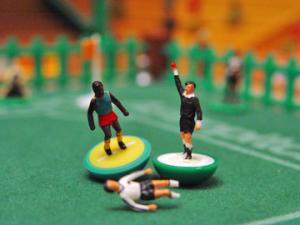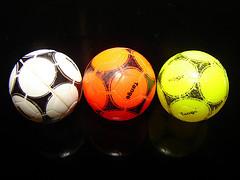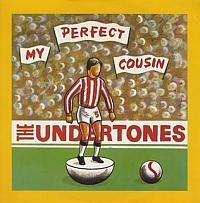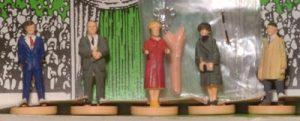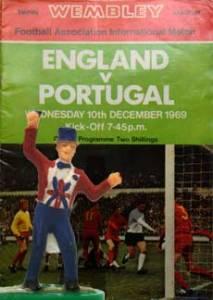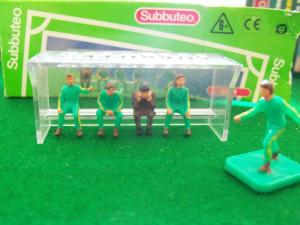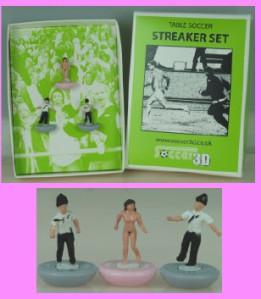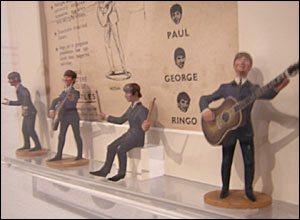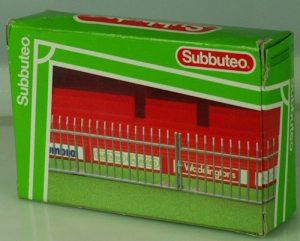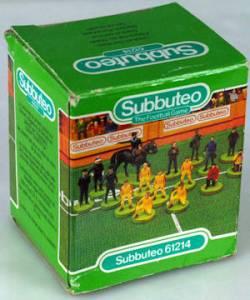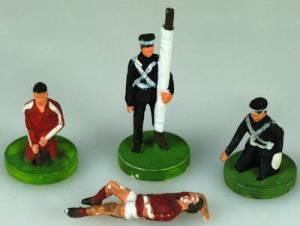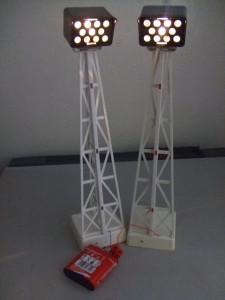First published back in 2010, this post on some of the stranger accessories available through the years for Subbuteo generated a lot of interest.
Nearly ten years on and there are even more add-ons available, to bring the game into the 21st century. One look at eBay and you can find the following items:
TV Studio with Sky Sports branding
Champions League Players entrance arch
Champions League advert boards
Premier League center circle graphics
In March 1947 in the small Kent village of Langton Green a game was invented that literally changed the past times of millions of children around the world. A chap there called Peter Adolph created a set of plastic footballers that he wanted to market in a game called “Hobby”. Unfortunately he could not get a trademark on such a generic name so he settled for the slightly similar Falco Subbuteo which was a bird of prey also known as the Eurasian Hobby (see what he did there…).
The first Subbuteo sets, known as the Assembly Outfits, consisted of goals made of wire with paper nets, a cellulose acetate ball, cardboard playing figures in two basic kits (red shirts with white shorts, and blue shirts with white shorts) and bases made from buttons weighed down with lead washers.
The first sets were eventually available in March 1947, several months after the original advertisement appeared. The first figures were made of flat cardboard cut out of a long strip. Later these card players came in press-out strips before being replaced with the two-dimensional celluloid figures, known to collectors as “flats”. In its early years, Subbuteo had a fierce rivalry with Newfooty, a similar game that had been invented in 1929 by William Keeling of Liverpool. In the run up to Christmas 1961 Adolph introduced a three-dimensional handpainted plastic figure into the range. After several design modifications, this figure evolved by 1967 into the classic “heavyweight” figure.
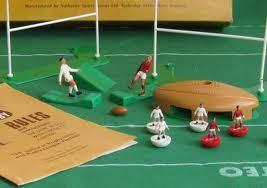
At first sales were slow, but then through sheer persistence and a stroke of luck in getting some endorsements the game became a household name for all young boys. With football hardly on television, and restricted to the radio, many a game was replayed “live” on the green baize whilst listening to the commentary of Peter Jones or Kenneth Wolstenholme.
Adolph turned his attentions to other sports, launching editions for Cricket and Rugby (as well as Baseball in the US) then completely losing the plot with Subbuteo Angling and Speedway if you can believe that! None of them really took off despite the fantastic introduction of the rugby scrum machine and the huge kickers which did lead to some kicking competitions for pocket money in the Fuller household. The record of 63 inches (measured by putting 9 7 inch singles on the floor end to end) still stands today for one of these successful kicks.
But it was football that held our attention. Simple to play with the rules of football but the ability to learn the tactics of the world’s greatest teams. Who didn’t try the crowding the goalkeeper corner technique and then shooting the ball in hoping for a lucky deflection.
It wasn’t long before the general public craved more realism. First game simple things like the different coloured balls. When Adidas introduced the Tango ball in 1978 I patiently coloured in my white balls with black pen, and likewise when the Surridge red and white ball was used in England.
Then came spring loaded goalkeepers so that they could tip the ball over the bar (as well as flick any forwards out of the way with amazing effects), the throw in experts that never worked but inspired one young man to say to his Mum “One day I want to throw the ball like a Subbuteo thrower” (Step forward Mr Delap).
The more they brought out, the more the public lapped up these accessories. Some people, mentioning no names, built a whole room full of the game. It became popular in pop culture as well, made famous by Half Man Half Biscuit in their song “All I want for Christmas is a Dulka Prague away kit” as well as The Undertones who featured a Subbuteo player on the cover of their single “My perfect cousin”.
So to what lengths could people go to to make their Subbuteo set more realistic? We’ve picked ten of the more unusual accessories that have been made throughout the years.
VIP Presentation set – Subbuteo was a big game game. There was no point in playing a pre-season friendly between Waltham Abbey (in a kit very similar to Celtic’s) and Hendon (aka Norwich City). Subbuteo was about the Cup Finals. And you could even buy the replica trophies as well, as seen here sported by Patrick Marber as Lewes took on Thurrock in this years competition although it was about 500 times bigger than the actual players. The trophy of course took pride of place on the half way line during those big games, but it was never really like real football was it? After all who would give the cup to the winning captain? Step forward the VIP set consisting of a Queen/Queen Mother type character (seen above holding a large carrot), a stereotypical 1970’s club chairman, a bloke who looks like Windy Miller from Camberwick Green and a random other chap who had obviously blagged his way into the VIP area.
Ken Bailey– Back in the 1960’s and 70’s Britain was still hanging onto their empirical traditions, lording it over the rest of the world as if we had a God given right to say We are British as an excuse for anything. Whenever England played abroad we would wheel out our “ambassador”, an old chap called Ken Bailey. Ken would be wearing a top hat, a Union Jack waistcoat and be waving a Union flag. When fans would be on the verge of rioting , in would wander Ken, offering a white gloved hand in peace all in the name of Britain. God bless Ken. Subbuteo brought out a limited edition Ken figure and initially was given away free with the official match programme from England v Portugal in 1969. Many a near riot in the Fuller household games of Subbuteo was saved after that day by the appearance of Ken on the green carpet.
Dugout – You could write a book about Dugouts. In fact I know a man who has done just that. So you could forgive Subbuteo for bringing this accessory out as one of the first additions to the stadium. Early models were made of a fake corrugated metal but they came into the modern age with a perspex version complete with the coaching team in tight green tracksuits and a suited manager who sat permanently with his head in his hands, although he did at least show more passion than Sven Goran Ericksson did as England manager. I painted the roof of my dugouts with big Home and Away signs in Tipex although Subbuteo only sold them with the same managerial team in green tracksuits and same depressed manager which was only useful when recreating dull West Ham versus Stoke City games.
Streaker set – Not actually an official Subbuteo release but has there ever been a better product to bring the game right up to date than a streaker set? Available in a male or female version complete with two unfit and overweight chasing policemen, what more pleasure could you have in flicking a naked female figure across the pitch. Rumoured to be available in Hollywood, Brazilian or Amazon Bush varieties the streaker would never be caught and would inevitably escape from the authorities and thus avoid a stadium ban by being flicked under the bed.
TV crew – Subbuteo was a world leader when it came to TV coverage. Long before Sky Sports took over our beautiful game with their super slo-mo 3D HD cameras Subbuteo launched its own TV crew comprising of a special TV tower and a few handheld cameramen who took up positions around the ground. In the days before the tactics truck was wheeled in behind the main stand we built TV studios from Lego with Lego men complete with toupee hairpieces representing Jimmy Hill and David Coleman. I also built a big screen behind the goal from Lego and covered it in tin foil to give that authentic seventies crap TV effect.
The Beatles – This is no joke. At the height of their Shea Stadium fame, Subbuteo brought out a limited edition Beatles figure set. If they would have made a Brian Epstein as well they could have formed a five a side team. Whilst they did not come with their own flickable bases they played a flat back four and were world beaters. And who better to play the virtual national anthem on the pitch before a big game? A mint condition boxed set of the fab four today fetches well over four figures.
Ken Bates style fences – In the 1980’s Ken Bates, then chairman of Chelsea, built huge fences around the edge of the pitch at Stamford Bridge, topping it off with barbed wire and then running an electrical current through it. What was so ironic about this was that he then parked disabled people’s cars right in front of the away section. So what better way to recreate that edgy caged animal effect than by erecting your own ridiculous tall fence around the pitch. In fact taller than two Subbuteo players on top of each other (so in ratio it would be about 12 foot tall). So to recreate those classic cup ties at The Den or Ayresome Park you spent hours putting all the fences together, because if you didn’t complete the whole perimeter it just kept falling over. And then once in place you realize that it is impossible to actually do important things like take corners or throw-ins, so you tore them all down just like Ken was forced to do.
Stadium services team – Any big game requires a support team to help make sure everything on the big day goes according to plan. And Subbuteo delivered the necessary resources. Ball boys all decked out in matching yellow tracksuits ready to be placed around the pitch and like in real life not budging an inch when a ball came anywhere near. Photographers who could be placed around the pitch ready to snap any major points around the ground, or simply focus on the good looking women in the crowd and missing the main talking point. And the chief of police, on his horse pointing accusingly at anyone and everyone. I always directed his accusation at my opposition goalkeeper to make him nervous.
First aid team – Subbuteo players were always in the wars. I do not ever remember finishing a game without at some point kneeling on one of them, flattening the poor mite. That called for immediate medical attention (not just for the player but for me – a condition known as Subbuteo knee was common in the Fuller household and required immediate ice). So what better accessory than a “trainer” complete with magic sponge (or in the case of West Ham’s Rob Jenkins, a bottle of Whiskey) and two old ambulance men complete with a stretcher left over from the Second World War. There was a sure fire way to avoid these injuries – play games at altitude, also known as the Dining Room table.
Floodlights – When I decided to write about ten Subbuteo accessories, there would always be a danger that I would not be able to give them all justice. The tenth in the list could have been the Marching Band, the terraces with the supporters you had to paint or what the hell, not ignoring the fact that the specialist corner kickers were actually three times the size of the other players. But I felt it would be an injustice to leave out the one and only accessory that required power – the floodlights. These hulking unstable lights provided absolutely no light whatsoever when they were wired up and would have failed any inspection from the Subbuteo Football Licensing Authority that is for sure. In fact they were one of the biggest wastes of money in the whole series of products. Turn the big light off and slowly feel your way to the pitch, treading on little players as you went and you would be soon cursing and swearing. For the price of two of these lights you could buy four reading lamps from British Home Stores and bathe the pitch in real light.
Most men aged between 25 and 50 have a Subbuteo story. Some even have their sets in the attic today. We all have our stories of past glories, of how Berwick Rangers managed to upset the mighty Real Madrid, or how you flicked a player the length of the pitch to slot the ball home in the six yard box.
Subbuteo did have some sense though. The offside rule was the perfect example. The creators added a line across the pitch 25 yards out from goal where players could not be judged offside in (towards the center spot and not the goal). Can you imagine if this line was introduced in the real game? Arsenal’s famous back four would have been useless, Pippo Inzhagi would have never been offside and linesmen would only have to run half the distance they do today.
And what about the goalkeeper on a stick? The rule we played was that if you flicked your keeper out of the net he had to stay there until there was a break in play, so the rush of blood to the head was only a last resort measure. And of course you couldn’t send him up for the last minute corner at the other end if you were trailing in a game.
I could go on forever, waxing lyrical about marathon cup competitions, replaying World Cup games, planning the matches for days in advanced and even producing match programmes (come on, admit it you made one too at some point). The excitement of spending your pocket money on a new overseas team, who were essentially the same as a British team. I remember paying £1.95 for Shaktar Donestk only to find out in the catalog that it was also Dundee United at cost just £1.50.
Today the game still has cult status. There are literally hundreds of clubs up and down the country. In September the Subbuteo World Championships were held in Bristol with a prize pot of £10,000, having been held around Europe every year since 1987. Computer games may have got more realistic year after year but sometimes you want the likes of Alloa Athletic turning over Barcelona right? Keep flicking.
